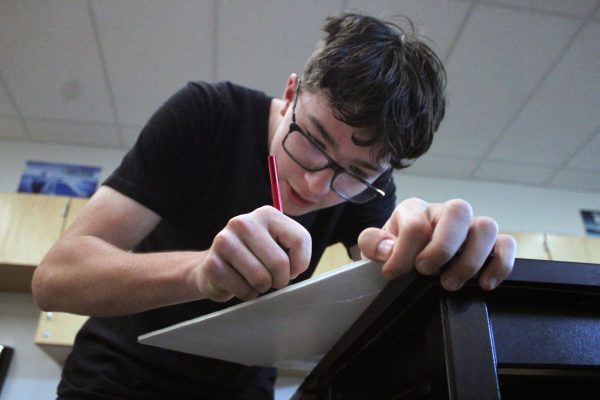‘Families In Transition Closet’ helps meet needs in community
When most people think of families they think of a group of blood related people in one house. That definition doesn’t always apply to every family or student, including 372 students. The 372 students is what the school districts classify as homeless.
Each year Manhattan High School receives a grant through the McKinney-Vento Act — a subsection of the Every Student Succeeds Act — and Title 1 from the federal government to be able to provide for the homeless students in the school district.
“Under the U.S. Department of Education there is a federal law called the McKinney-Vento Homeless student act,” coordinator of grants and compliance Stan Ward said. “That requires every school district in the country to identify homeless students.”
Through the McKinney-Vento act and Title 1 the school district receives about $20,000 per year, which must aid the homeless students.
“[The] money has to be used for educational purposes and to have them fully participate in school,” Woodrow Wilson Elementary School social worker Cheryl McCormick said. “Sometimes that money is used for transportation, sometimes it’s for kids who need eyeglasses or they lost their glasses.”
But sadly, the grant isn’t able to fund all of the basic needs that should be met.
“Making sure that we are to provide the services that are necessary for all kids is always a challenge,” Ward said. “In fact up until we developed the [Family In Transition] Closet [and Clothing Exchange] three years ago, we had reached a point where we simply could not provide the most basic services for every kids that needed them, because of the cost of clothing and transportation. It was just eating our budget a lot.”
The Family In Transition Closet and Clothing Exchange originally started in the back of McCormick’s van.
“People would donate things because they knew that I had these needs for kids. Kids need clothes, kids need shoes,” McCormick said.”Other families would outgrow their stuff, they’d be a good save, and they would be like ‘hey, do you want this?’ I never wanted to turn anything away.”
The F.I.T. Closet and Clothing Exchange has grown so much that they are now able to reach other members of the community.
“In fact we set [the F.I.T. Closet] up specifically for homeless kids and it has grown to the point that we have opened it up to all of the kids in the community who have a Court Appointed Special Advocate,” Ward said. “We’ve opened it up to foster kids. We’ve opened it up to migrant kids. In general we serve any school child in Manhattan where a social worker, teacher or principal say the child has a special need. It has gone from just serving homeless kids to this broad segment of children in USD 383 that for whatever reason have a special need.”
Being one of the few school districts that offers this type of program allows for the community to have a unique connection with donating to the F.I.T. Closet and Clothing Exchange.
“We’ve tapped into the community as a whole it’s not just the churches that donate, but businesses and individuals,” volunteer coordinator of the F.I.T. Closet Barbara Hartnett said. “We have a very broad email base. When people come to the F.I.T. Closet to donate they’re asked to write down their email address and we email them monthly what’s happening at the F.I.T Closet.”
Families that use the F.I.T. Closet and Clothing Exchange also give back to it when they can.
“The families that are participating and receiving, are actually giving,” Hartnett said. “Many of the families that receive things from us, actually donate to the F.I.T. Closet themselves. As their children outgrow themselves, or they no longer need things.”
The school district was able to gain support three years ago from an article in the Manhattan Mercury written by Bryan Richardson about a Board of Education meeting. The article focuses on the actions taken by the school district to help the homeless students.
“That newspaper article [in the Manhattan Mercury in 2013] hit the community like a bomb shell and all of a sudden everyone in the community wanted to help with homeless kids,” Ward said.
Even with the addition of the F.I.T. Closet and Clothing Exchange, the school district isn’t able to meet every need for the homeless student program.
“We still have things that we aren’t able to do, federal law requires that for an unaccompanied minor — children without parents — we’re supposed to be able to provide a mentor for them to help them get through school,” Ward said. “We’re working hard to get that kind of program started…but we haven’t had a volunteer like Hartnett yet to come in and say they’ll do this for us.”
If you would like to help out with the F.I.T. Closet contact Barbara Hartnett at [email protected] or go to 1609 College Ave. Monday, Wednesday and Thursday mornings from 9 a.m. to noon and Wednesday and Thursday afternoons from 3 p.m. to 5:30 p.m.
STATS:
Number of homeless students: 303 (as of Feb. 3)
Rate of homeless students increase by: 10% (each year)
Number of foster care students: 69 (as of Jan. 21)
Length the F.I.T. Closet has been open: 3 years
Number of location changes: at least 4 times
Percent of Community support: 100%
Number of homeless students when F.I.T first opened: 269 (3 years ago)
Number of homeless students when McKinney-Vento Act began: 70
Number of people, businesses, or groups on the email list: 300+
Amount of money in the Federal Grant that MHS receives: $20,000



